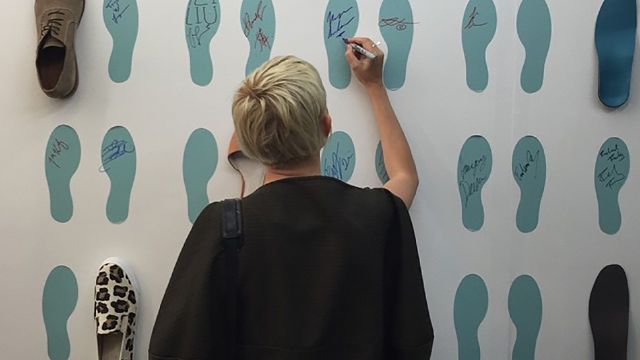Foot pain sufferers find relief from 3D printer
An EU-funded project has developed a way to quickly make customised corrective foot and ankle supports using 3D printers – and the results are already on the market.

How Kegan Schouwenburg is creating print your own shoes. Amy Poehler’s Smart Girls
Horizon 2020 April 4, 2014
Around 200 million Europeans are estimated to suffer from disabling foot and ankle conditions. Europe’s health services spend over €300 million each year treating many of these patients with foot supports, typically worn inside the shoes or as splints.
Known as orthoses, supports can be mass-produced. Made this way, such supports cannot be easily adjusted to each patient for the most effective treatment. Meanwhile, custom-made foot supports work more effectively, though they can be expensive and time-consuming to make.
Current methods and foot models used to assess a patient can also result in the wrong prescription being made. Patients often have to make repeat visits for corrections to their supports.

Figure 5. Adjustable stiffness ankle foot orthosis. A) In the lower stiffness condition, when the gas spring on the medial side compresses to provide resistance to plantarflexion, the disengaged spring on the lateral side is free to slide down its support bracket without giving any resistance. B) The slider component provides the upper attachment point of the gas springs and is held in place by two M6 bolts (one above and one below). By adjusting these bolts the slider can be moved up and down, and this alters the shank to foot angle. The adjustment range is approximately 6° of anterior and posterior tilt. C) The shank section is mounted on runners to allow it to move up and down freely. This is intended to reduce friction between the calf and this component of the device during gait. Embracing additive manufacture: implications for foot and ankle orthosis design
The EU-funded project A-FOOTPRINT has developed a faster, more efficient way to make more effective foot supports customised to each patient. Project coordinator professor Jim Woodburn of Glasgow Caledonian University says the team’s researchers developed innovative foot models, which when combined with computer-aided design and 3D printers, allow the manufacture of more accurate foot supports. 3D printing manufacturing technology works by building up thin layers of plastic to create an object, in this case foot supports.
| Professor Jim Woodburn, Dr Scott Telfer and Paul Charlton of Glasgow Caledonian University talk about the A-FOOTPRINT project, a European collaborative project involving innovative 3D printers. watchgcu. YouTube Apr 3, 2013 |
| The dynamic foot |
A-FOOTPRINT’s researchers studied the gaits of healthy adults and patients with a range of foot and ankle disabilities. They combined these data with sophisticated real-time imaging of foot motion to develop the most accurate model of foot-dynamics achieved to date, says Woodburn.
Using this model, orthotics specialists place skin-markers on anatomically significant points of the patient’s foot during assessment. The foot is then scanned in 3D, instead of plaster of Paris or foam impression casts.
The motion of these points, combined with analysis of pressure points on the sole of the foot, is stored by the project’s information system. The project’s software (POD-CAD) then uses these data and clinical information about the patient to design a custom support.
The foot support is then created using 3D printing. The technique, developed by the project, slashes both the cost and time to manufacture, says Woodburn.
Compared to the current two-week turnaround to provide a shoe insert or splint, the A-FOOTPRINT process could take just one day, he says.
The large European market for braces and supports is growing at 6% annually, and A-FOOTPRINT currently has no competitors for the type of products it can offer, says Woodburn.
“Some of the project’s innovations are available already,” he adds. Peacocks Medical Group, a project partner, is already selling foot orthotic products – licensed in conjunction with the project’s other partners – under its PODFO brand. PODFO claims to be the first commercially available 3D-printed functional foot orthosis to offer design flexibility and precise customisation.
The project’s foot model presents opportunities beyond the orthotics sector. The model can be used for biomechanical research applications – prosthetics and implants for example – and for designing sports shoes.
“The POD-CAD system developed by our project also has excellent prospects for commercial exploitation within the next year or two,” adds Woodburn.
Source Horizon 2020 European Union
| References |
Embracing additive manufacture: implications for foot and ankle orthosis design, Telfer S, Pallari J, Munguia J, Dalgarno K, McGeough M, Woodburn J. BMC Musculoskelet Disord. 2012 May 29;13:84. doi: 10.1186/1471-2474-13-84.
Also see
Newcastle University release code to streamline 3D printing design 3D Printing Industry
A-FOOTPRINT uses 3D printing to create most accurate custom foot supports 3ders.org
Beyond State of the Art A-Footprint
